时间:2024-02-27|浏览:316
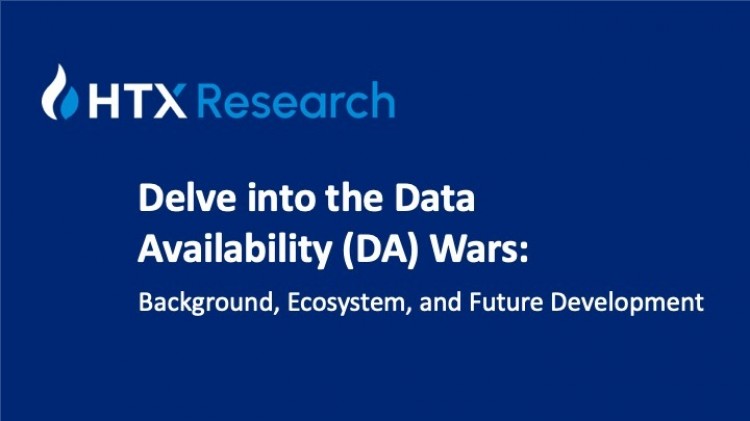
数据可用性(DA)项目市场正在快速扩张,竞争环境日趋激烈。
该领域的著名参与者包括 Celestia、EigenLayer、Avail、NearDA、Covalent 等。
根据HTX Research的分析,DA背后的核心技术并不像表面上那么要求高。
最简单的 DA 形式可以通过一台机器实现,而更复杂的方法(例如 Celestia)则采用分散采样方法。
DA本质上是围绕存储展开的,这会产生高昂的成本。
如果以太坊级别的安全服务不是绝对必要的,那么选择 DA 提供商就成为成本和安全性之间的权衡。
原则是服务的价值越高,DA 应该越安全。
这份报告由 HTX Research 出具,对 DA Wars 的背景、生态系统和未来发展进行了深入分析。
其中还包括V神对DA的见解,并对不同的DA项目进行了分类。
基于对 DA 格局的综合分析,HTX Research 认为 DA 的未来可能是去中心化的,拥有 7-8 个主要 DA 提供商可能足以满足未来市场的需求。
1.DA问题的出现
1.1 什么是DA
简单来说,数据可用性(DA)是指区块生产者将区块的所有交易数据发布到网络上,使得验证者能够下载。
如果区块生产者发布完整的数据并允许验证者下载它,我们就说该数据可用。
然而,如果区块生产者扣留了一些数据,导致验证者无法下载完整的数据,我们就说该数据不可用。
1.2 DA问题的两个关键方面:安全性和成本
在检查了 DA 的定义之后,我们可以清楚地看出它由两个关键方面组成:
第一,保证验证机制的安全;
二是降低数据发布成本。
确保验证机制的安全
为了确保安全验证,当前的 L2 定序器通常将 L2 状态数据和交易数据发布在高度安全的以太坊网络上,依靠以太坊进行结算和 DA。
因此,DA层才是L2真正发布交易数据的地方。
目前,主流的L2解决方案使用以太坊作为DA层。
降低数据发布成本
目前L2只是简单地依赖以太坊进行DA和结算。
虽然这种方法提供了足够的安全性,但它也会产生大量成本。
这给L2带来了第二个挑战:如何降低发布数据的成本。
2. DA成本结构及降本增效途径
从第一章的介绍中我们可以看出DA的重要关注点之一就是如何降低成本。

Therefore, if you aim to make L2 cheaper overall, you must reduce the cost of publishing data. So, how to reduce costs? There are two main methods:
Reduce the cost of publishing data on L1, such as the upcoming EIP-4844 upgrade of Ethereum.
Following the example of Rollup, which separates transaction execution from L1, DA can also be decoupled from L1 to reduce costs. In other words, Ethereum is not utilized as the DA Layer.
Therefore, all parties have made considerable efforts to reduce costs. After comparing the currently available plans, the cost of Near DA is the lowest, at about $0.0016 per block, followed by Celestia, EngenLayer, EIP4844, and so on.
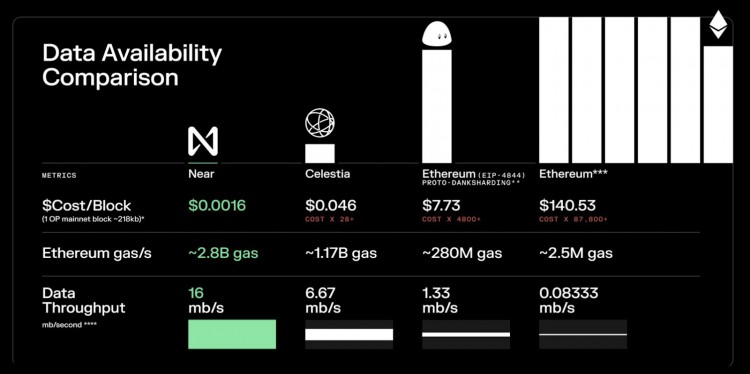
3. Vitalik’s View on DA
3.1 Ethereum Foundation and Vitalik Buterin Support Use of Ethereum for DA
After Celestia went viral, the co-founder of Ethereum, Vitalik Buterin implied that Ethereum’s L2 projects must utilize DA on the Ethereum blockchain. Subsequently, Ethereum Foundation researcher Dankrad Feist stated in a tweet that it’s not a Ethereum Rollup without using Ethereum as the DA Layer, and therefore, it’s not L2.
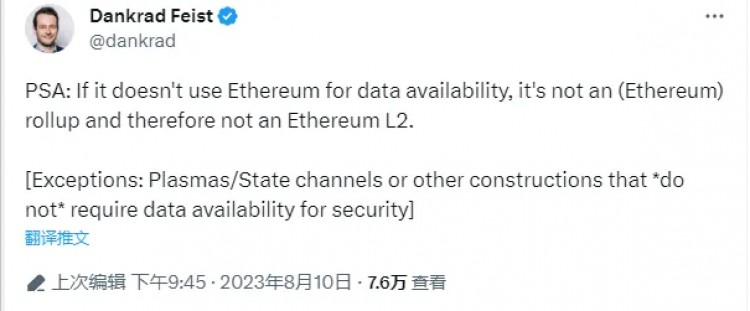
In that case, Arbitrum Nova and Mantle should be “delisted” from the L2 projects because they only disclose transaction data on DAC, outside the Ethereum blockchain.
At the same time, Dankrad also mentioned that solutions like Plasmas and state channels that do not require on-chain data availability (DA) to ensure security are still considered L2, but Validium (ZKRollup that does not use Ethereum as the DA Layer) is not considered L2.
3.2 Vitalik’s Compromise: Ethereum Rollups Utilizing External Data Chains for DA Classified as Ethereum Validium
Later, in a response on his X, Vitalik Buterin stated, “Being a Validium is a correct choice for many apps, and using good distributed DA guarantee systems can be a good way to increase the practical security of a Validium.”
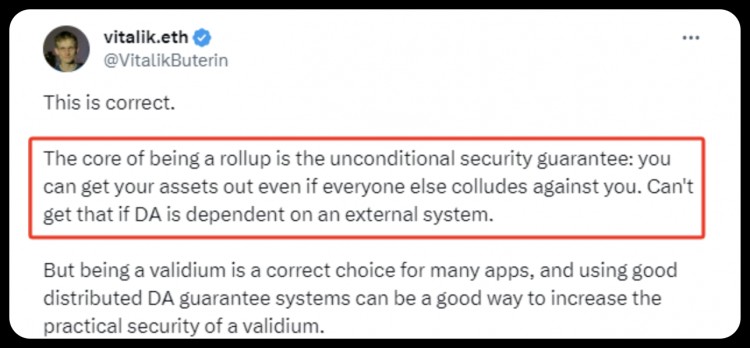
Moreover, he believes that the core of being a rollup is the unconditional security guarantee: you can get your assets out even if everyone else colludes against you, and you can’t get that if DA relies on an external system.
3.3 Consolidating Control over DA through ENS: Vitalik’s Vision
The ENS domain name service will define a set of interaction logic. Users will only need to enter a short domain name to automatically connect to the associated long address corresponding to the ENS smart contract, thus addressing the pain points of complex, difficult-to-remember, and hard-to-identify EOA addresses. It should be noted that this set of domain name services of ENS points to the future expansion market with larger user traffic, especially some Mass Adoption user groups. L2 is the future for Ethereum to expand and absorb large traffic.
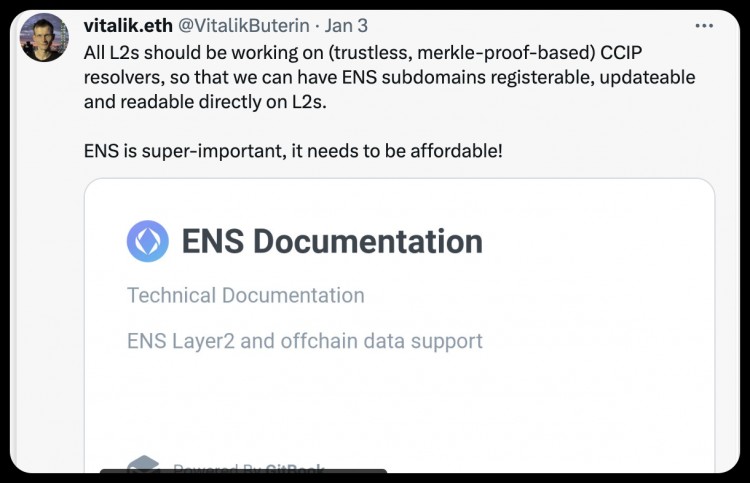
Vitalik believes that if ENS’s domain name resolution solution doesn’t extend to L2 and remains restricted to the Ethereum mainnet level, it will be difficult to open up space for imagination. Based on this background, he emphasized the importance of ENS on X, “It needs to be affordable!” ENS will naturally consider providing a complete set of data parsing solutions for L2, allowing users to directly perform domain name resolution and data search on L2. This reduces the dependence on their respective L2 centralized gateways.
It is not difficult to see that for users to use the ENS domain name normally on L2, the prerequisite is to access and verify the global data on the Ethereum mainnet. This means that to enjoy the set of services of ENS, you must use the orthodox Ethereum DA capability, and those L2 solutions based on OP Stack’s shortcut and placing DA on third-party platforms such as Celestia are not compatible with ENS. Having said that, it is not difficult to understand Vitalik’s intention. In short, Vitalik is striving to use ENS to define a standardized set of interoperability specifications for L2 platforms, while simultaneously tightening control over DA.
3.4 Vitalik Discussing Plasma’s Resurgence
In Vitalik Buterin’s article, he discusses the various L2 scaling solutions originally proposed for Ethereum, including Plasma, Rollup, Validium, and Parallel. Vitalik’s vision for scaling entails a balanced development of these solutions, tailored to different application scenarios. However, the current market landscape is predominantly shaped by the Rollup solution, which is becoming increasingly competitive.
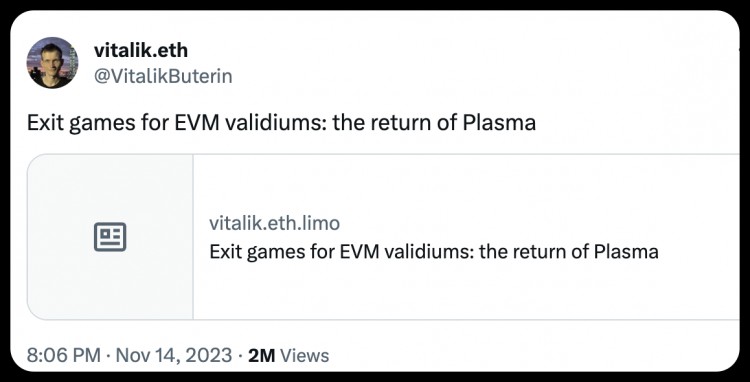
Plasma, a sidechain solution, periodically syncs Merkle state data with the main network. It is a scaling solution that depends on the main network for data and computation. This allows Layer 2 to scale efficiently through a highly centralized approach and the design of a complex ledger model, while also leveraging the system capabilities of the main network validators. Vitalik’s new article revisits Plasma and introduces a ZK+Plasma scaling solution, which is evidently another strategic move in the L2 landscape.
3.5 Summary
All of Vitalik’s actions can be summarized as:
Vitalik Buterin has acknowledged the high demand for DAs, but he is reluctant to cede market share to Celestia. Initially focusing on security concerns, he highlighted the importance of the ENS, but encountered resistance from the market. Despite his efforts, many users continue to prefer first-party DAs. He then suggested that Validium could be a viable alternative, only to revisit the older Plasma solution days later, aiming to steer the market towards exploring the ZK+Plasma direction. In essence, Vitalik’s strategic maneuvers reflect a continuous endeavor to anchor the DA market within the Ethereum ecosystem.
4. Overview of DA Solutions and Various DA Projects
4.1 DA Solutions
Based on the provided content, we can see that there are many solutions for the DA Layer. Broadly, these solutions can be categorized into two main parts: on-chain and off-chain.
On-chain solutions
Refer to L2 solutions that still utilize Ethereum as the DA Layer, leveraging Ethereum to mitigate DA costs. This implies that Ethereum will evolve into a real-time bulletin board in the future, with data on the board being deleted after a certain period. L2 solutions must develop methods to independently store all data backups.
Off-chain solutions
Refer to strategies that no longer rely on Ethereum as the DA Layer, seeking more cost-effective methods to ensure DA. Based on variations in decentralization and security, off-chain solutions can be categorized into four types: Validium, Data Availability Committee (DAC), Volition, and general DA solutions.
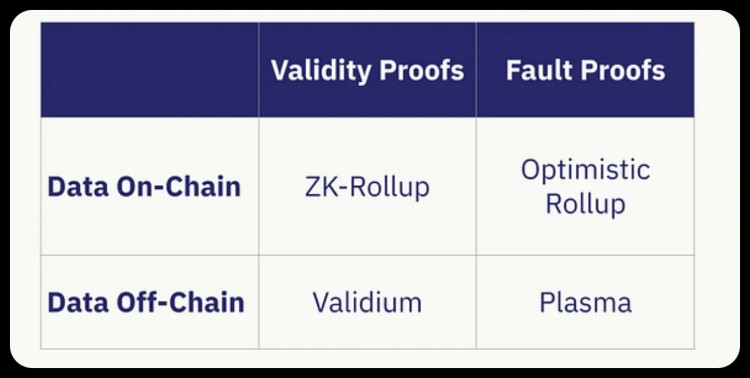
4.2 Celestia
A pioneer in modular public chains, Celestia is built on the Cosmos SDK with a primary focus on DA. It stands as a competitive leader among DA projects that have already launched the mainnet.
Technical features
Data Availability Sampling (DAS)
DAS allows light nodes to verify DA without having to download the entire block. Light nodes download only the block headers, which limits their ability to verify the DA of a block since they lack access to the full block data. Celestia uses a two-dimensional Reed-Solomon (RS) encoding scheme to re-encode block data to enable DAS for light nodes. DAS works by having light nodes randomly sample a small portion of the block data. As light nodes complete more rounds of block data sampling, confidence in the availability of data increases. Once light nodes have successfully reached the predetermined confidence level (e.g., 99%), the data is considered available.
Namespaced Merkle Trees (NMT)
NMT allows the execution layer and settlement layer on Celestia to download only transactions that are relevant to them. Celestia partitions the data in a block into multiple namespaces. Each namespace corresponds to an application built on Celestia, such as a rollup. Each application only needs to download the data that is relevant to it, improving the efficiency of the network.
Celestia derives its primary revenue from applications through two main methods:
Blob Space Fees: Rollup applications utilize $TIA to pay for storing their data in Celestia’s blob space.
Gas Fees: Developers use $TIA as the gas token for Rollup transactions, similar to how ETH is used as gas in Ethereum-based Rollups.
Development Potential
The project has successfully launched and has achieved a high level of technical maturity.
It boasts exciting prospects for rewarding airdrops, targeting participants who have staked $TIA tokens. Projects such as Dymension and Altlayer specifically select $TIA stakers as recipients for their airdrops. Likely, more Ethereum L2 projects, modular blockchain solutions, and projects within the Cosmos ecosystem will adopt a similar airdrop strategy.
The ecosystem is enriched through collaborations with cross-chain bridges, settlement layer solutions, DeFi projects, gaming platforms, and oracles.
The list of collaborative partners in the DA domain continues to expand, and notable collaborators include Manta, Eclipse, Caldera, and Snapchain. In addition, it also integrated with Arbitrum Orbit, Polygon’s CDK, and the Aevo derivatives trading platform, among others.
4.3 EigenDA
EigenLayer is an Ethereum-based restaking protocol that enables users to restake their ETH, lsdETH, and LP Tokens on other sidechains, oracles, middleware, etc., as nodes and receive validation rewards. This allows third-party projects to leverage the security of the Ethereum mainnet, while ETH stakers can earn additional income, creating a win-win situation.
EigenDA is a decentralized DA service built on Ethereum using the EigenLayer Restaking framework. It serves as the inaugural Active Validation Service (AVS) on the EigenLayer platform. In contrast to Celestia or Avail, EigenDA doesn’t require bootstrapping a new set of validators. Ethereum validators have the freedom to choose to join EigenDA at their own discretion.
Technical Features
Enhancing Ethereum’s DA Capability: Blob Block Data and KZG Commitment
EigenDA leverages the upgraded Blob block data and KZG commitments introduced in the Cancun upgrade. The Rollup chain can generate erasure codes and KZG commitments for Blob Data, which are then published to the EigenDA contracts. The nodes within EigenDA ensure the subsequent DA capabilities for the chain. This significantly boosts Ethereum’s DA capabilities. Notably, EigenDA’s entire operation is built upon existing Ethereum infrastructure like Blob and KZG. Additionally, validation tasks for EigenDA nodes are performed by Ethereum Validators.
P2P Networks with No Central Authority
EigenDA nodes must re-stake ETH (or more precisely, stake ETH derivatives) in the EigenLayer contract on Ethereum Layer 1. EigenDA nodes are a subset of Ethereum validators. Then, after the DA buyer (e.g., rollup, also known as disperser) receives the data blob, it encodes it with erasure code and generates a KZG commitment, which is published and distributed for node confirmation. Afterwards, the disperser collects these signatures one by one, generates an aggregated signature, and publishes it to the EigenDA smart contract, which verifies the signature.
Adopting Delegated Proof-of-Stake (DPoS)
Instead of employing DA sampling, EigenDA utilizes the DPoS consensus mechanism to verify whether nodes genuinely store data. Anyone can submit proof to the EigenDA smart contract, which will be verified by the contract itself. If the verification is successful, the Lazy Validator is slashed.
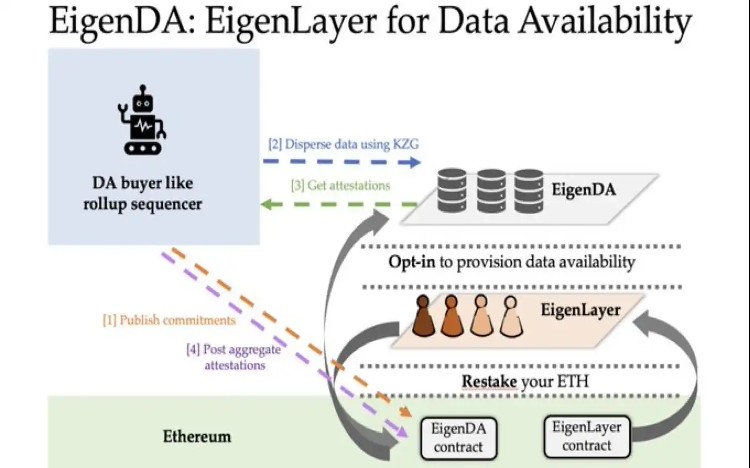
Development Potential
Engaging in competition with Celestia, EigenDA has integrated several L2 projects, including Celo, Mantle, Fluent, Offshore, OP stack, among others, as collaborative partners.
Backed by Eigenlayer’s diverse ecosystem, which includes sorters, cross-chain bridges, oracle machines, and more.
4.4 Other DA Projects
4.4.1 Avail
Avail can efficiently sort and record transactions, provide storage and verification of DA, support EVM-compatible blockchains, and enable Rollups to publish data directly to Avail. Additionally, its light client network verification mechanism (to be introduced below) allows Rollups on Avail to verify the state through the light client network without relying on smart contracts and the underlying layer. Due to its modular nature, developers can store data on Avail and choose other networks for settlement.
Using the BABE and GRANDPA consensus mechanisms inherited from the Polkadot SDK.
Decentralized.
Avail adopts Nominated Proof of Stake (NPoS) which allows it to support up to 1,000 validators (in Mainnet). This mechanism, along with an effective reward distribution mechanism, minimizes the risk of stake centralization.
Avail is unique among all DA solutions in its ability to sample data from its light-client P2P network. Because of this feature, Avail provides an efficient and reliable backup mechanism that ensures DA even in the event of a failure.
Validity Proof: Avail utilizes KZG polynomial commitments.
Current Status: The Avail mainnet has not yet been launched.
4.4.2 Near DA
On November 8, 2023, the NEAR Foundation announced the launch of the NEAR DA Layer, which provides a robust, cost-effective DA for ETH rollups and Ethereum developers. The first users include Madara by StarkNet, Caldera, Fluent, Vistara, Dymension RollApps, and Movement Labs.
Security: Inherits the security of the Near network.
Cost Advantage: 100kB calldata on NEAR costs $0.0033.
Current Status: NEAR DA has integrated with Polygon CDK, empowering developers to build Ethereum ZK Rollups.
4.4.3 Covalent
Covalent is a blockchain data query service platform that can standardize data from multiple blockchains. Its unified API allows developers to reuse queries across supported networks, solving the problem of blockchain data being difficult to obtain.
After the Cancun upgrade, the Ethereum mainnet will only store L2 submitted state data for 1 month, after which it will be discarded. In order to maintain the decentralization of the network and establish the DAS light node mechanism, Celestia will also regularly discard the L2 submitted state data. However, in November last year, Covalent launched the “Ethereum Wayback Machine (EWM)” for long-term storage of L2 state data discarded by the blob. Covalent is responsible for reading the L2 state data.
Covalent goes beyond simple storage and integrates L2 data into its platform’s on-chain data API service. Covalent facilitates seamless user access to blockchain data, providing data service support for specific user groups such as blockchain data websites, government regulatory departments, AI researchers, and more.
Current Status: As of December 2023, Covalent supports over 210 blockchains and plans to support over 1000 blockchains by the end of 2024. Based on a recent Covalent DA report by Messari, it’s evident that Covalent boasts billions of data points, making it the best choice for applications requiring widely applicable and universally relevant data.
4.4.4 zkPorter
zkPorter, an off-chain DA solution optimized for decentralization, was launched by the Ethereum scaling solution zkSync. It handles DA through a hybrid approach that combines zkRollup and sharding ideas. zkPorter introduces an optional validator mechanism, where zkSync token holders stake tokens to later verify and sign blocks. In the absence of recent updates, zkPorter’s development has been closely watched. The GRVT chain, operating as a Layer3 application chain on the zkSync platform, is set to launch its mainnet in the first quarter of this year. Given the project’s reliance on zkPorter for data storage, there is speculation that zkPorter’s launch might precede that of GRVT.
4.5 Comparison of DA Projects
Technical aspects:
Technical aspects:
ProjectTechnical Feature
CelestiaIt utilizes a DAS scheme, adopts a two-dimensional RS erasure code encoding scheme to ensure data recoverability, enables light nodes to access block data through random sampling, and submits DA proofs in an Optimistic approach.
Ethereum (Proto-Danksharding)It also utilizes a DAS scheme and adopts a two-dimensional RS erasure code encoding scheme to ensure data recoverability. However, in contrast, Ethereum is set to employ the KZG commitment scheme for DA proofs. KZG (Kate Zaverucha Goldberg) polynomial commitment represents a zero-knowledge proof system. Similar to the distinction between Optimistic Rollup and ZK Rollup, Optimistic proofs feature a lower technical threshold for implementation, while KZG polynomial commitments demand a higher technical standard but offer faster proof submission speeds.
AvailIt also employs a DAS scheme, with a specific implementation similar to Proto-Danksharding, utilizing RS erasure code encoding scheme along with KZG polynomial commitments.
EigenDAIt is the flagship product of EigenLayer, and its solution shares similarities with Ethereum’s Proto-Danksharding, utilizing an RS erasure code encoding scheme along with KZG polynomial commitments.
Arbitrum NovaIt is completely different from the aforementioned four projects in terms of DA implementation. It employs the Data Availability Committee (DAC) mode, where transaction data is stored and provided by an external DAC. At least six out of the seven committee members submit BLS signatures to ensure data reliability. Compared to the DAS scheme, the DAC method incurs lower costs but sacrifices decentralization and security to some extent. However, it does not compete with the above projects and only represents a DA solution.
zkPorterIt integrates ZK Rollup and sharding in its design to address the DA problem. It has the capability to support any number of shards, with each shard able to select and establish its own DA scheme. This ensures greater flexibility in the development of smart contracts.
Performance aspects:
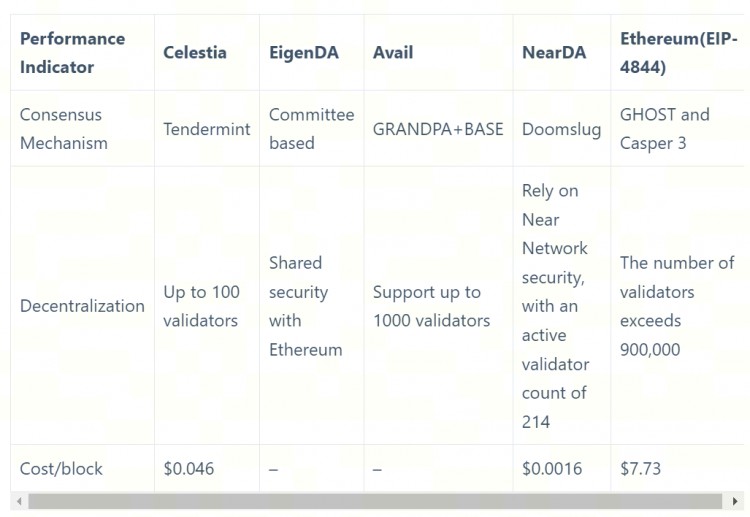
Among the aforementioned DA projects, the most competitive ones include Celestia, EigenLayer, Avail, and NearDA. Covalent, on the other hand, adopts an unconventional approach, leading to unique demand for its DA applications.
Of all the DA solutions, DAS coupled with KZG polynomial commitment emerges as the most mainstream approach. It ensures DA while simultaneously reducing node costs and enhancing proof efficiency.
From a technical standpoint, Ethereum Danksharding and Celestia stand out as the most decentralized solutions. They employ sampling technology, which effectively reduces node performance requirements while achieving high bandwidth. EigenDA follows closely with its use of sampling; however, it operates as a parasitic system on Ethereum, with its node count being a subset of Ethereum’s. Other DA projects, like NearDA, do not utilize sampling. For instance, the decentralization level of NearDA is equivalent to that of Near Protocol.
Celestia has chosen the Optimistic proof, which features a lower landing threshold and higher technical maturity compared to KZG polynomial commitment. However, its future technical potential may not match that of KZG polynomial commitment. In comparison with similar projects like Avail and EigenDA, Celestia’s development progress is currently faster, positioning it to launch its mainnet sooner. Nonetheless, Celestia will also confront direct competition from Ethereum following the Cancun upgrade.
As a L2 developer, the trade-off between DA authenticity and chain issuance cost is always a critical consideration. DA authenticity tends to be relatively passive in the commercial market, making it suitable for comprehensive L2 projects that prioritize security consensus issues and possess a certain brand background and market foundation. However, new and small L2 projects, especially those based on OP Stack for one-click chain issuance, strive to minimize costs as much as possible. For them, third-party DAs like Celestia are naturally a better choice. While Eigenlayer still struggles to reduce the actual development costs for L2 project developers.
However, for DA Layer projects, their scenarios are often singular, focusing on a business-to-business (B2B) model. These projects struggle to attract substantial liquidity compared to comprehensive public chains like Solana, which can draw decentralized applications (DApps) through consumer-to-consumer (C2C) scenarios. Without successful adoption by many Rollup projects, their ecosystem construction remains weak. Moreover, Celestia appears to lack significant capital backing. While the technical aspects of Celestia appear logical and feasible, its ultimate success hinges on its ability to integrate and flourish within the Ethereum ecosystem. Otherwise, its ambitious plans may languish unrealized, becoming mere illusions.
5. DA Layer and Modularity in Blockchain
DA Layers have always existed, whether in Bitcoin, Ethereum, or Solana blockchain. For example, in the Bitcoin network, data is stored directly on the blockchain. Fifteen years ago, Satoshi Nakamoto published the Bitcoin whitepaper and limited the block size to 1MB. The block size determines the maximum transaction data each block can accommodate. Later, SegWit, Taproot, and the Ordinal protocol, in a way, were also introduced to enhance DA on the BTC network.
In the Pre-4844 Ethereum network, all data transmitted from L2 to Layer 1 is stored in Calldata. While Rollup transfers computation security to L2, storage remains on Layer 1. Due to the limited storage capacity of Layer 1, the capacity of Rollup on Ethereum is constrained. The block size of Ethereum is about 150K-250K. Even if all the space is allocated to Rollup, the storage space remains limited, thereby constraining the throughput of L2. Therefore, Ethereum needs to adopt Proto-Danksharding, which enhances DA by introducing a new transaction type that includes blobs.
Therefore, it can be said that the DA Layer is actually an abstracted layer that accommodates the expansion needs of various blockchains and the increased requirements for DA. It reflects the evolution and development of blockchain technology, resembling the refinement of labor division in human development processes. Notably, modular blockchain decouples specific functional layers from a monolithic blockchain, outsourcing them to other blockchain networks, thus achieving further division of labor to a certain extent and enhancing efficiency.
Celestia Proposes the Modularity in Blockchain
The architecture of a traditional monolithic blockchain typically consists of four functional layers:
Execution Layer: The execution layer is mainly responsible for processing transactions and executing smart contracts. It includes transaction verification, execution, and state updates.
DA Layer: The DA Layer in a modular blockchain is responsible for ensuring that the data in the network is accessible and verifiable. It usually includes functions such as data storage, transmission, and verification to ensure the transparency and trust of the blockchain network.
Consensus Layer: The consensus layer is responsible for the protocol between nodes to achieve the consistency of data and transactions in the network. It verifies transactions and creates new blocks through a specific consensus algorithm (such as PoW or PoS).
Settlement Layer: The settlement layer is responsible for completing the final settlement of transactions, ensuring the transfer of assets, storing permanent records on the blockchain, and determining the final state of the blockchain.
Celestia first introduced the concept of modularity in blockchain, which involves decoupling different functional layers from the monolithic blockchain. This approach allows the blockchain to concentrate on the specific functions of each layer and effectively distribute the workload to maximize overall availability.
The statement does not assert that a modular blockchain is necessarily superior to a monolithic blockchain. Instead, it expresses a desire to examine the future development of blockchain from a modular perspective. This approach enables the exploration of a broader spectrum of possibilities and conjectures.
6. Speculations About the Future
6.1 Blockchain Combination: A Modular Perspective
In the previous paragraph, it was noted that a blockchain can be divided into four layers from a modular perspective: the execution layer, the DA Layer, the consensus layer, and the settlement layer.
Let’s take the Ethereum ecosystem as an example. In this context, the consensus layer refers to the Ethereum main chain.
In the Ethereum ecosystem, the potential number of possibilities for modular blockchain in the future can be determined using the formula: Number of possibilities = Number of execution layer solutions * Number of settlement layer solutions * Number of DA Layer solutions.
6.2 The Decentralized Nature of the DA Layer
DA Layers can emerge rapidly, akin to mushrooms after spring rain, due to the fact that DA isn’t overly difficult. The simplest approach to DA is to implement it on a single machine. The most complex method involves decentralized sampling, as seen with Celestia. Decentralization via sampling means that the more nodes there are, the greater the bandwidth (imagine a peer-to-peer movie download network). This also generates network effects, suggesting that there won’t be too many of these ‘decentralized sampling DAs’ in the end. However, there are no restrictions on other forms of DA, and their potential is boundless.
Let’s use an analogy: DA functions as storage, which can be costly. If you don’t require Ethereum-level security, selecting a DA provider becomes a trade-off between cost and security.
The principle is the higher the value of the service, the more secure the DA should be.
Therefore, future DAs may be decentralized. Even so, perhaps 7-8 major DAs might be sufficient.
6.3 The Potential of a Specialized DA Layer in ETH 3.0
以太坊从1.0到2.0的升级,将以太坊分为执行层和共识层。
新引入的blob也将被纳入信标链的共识层。
未来,可能在下一次以太坊升级中,在技术进步和增加 DA 的推动下,以太坊可能会在执行层和共识层之上合并一个专用的 DA 层。
或者,类似分片链的专用数据存储链可能会在下次升级中出现。
这些都是推测性的情景,实际的发展方向还有待观察。
— — — — — — — — — — — — — — — — — — — — — — — — — — — — — — — — —
本文是目前 HTX Ventures 旗下 HTX 研究团队辛勤工作的成果。
HTX Ventures 是 HTX 的全球投资部门,集投资、孵化和研究于一体,旨在寻找全球最优秀、最聪明的团队。
HTX Ventures 目前支持跨越多个区块链领域的 200 多个项目,其中精选的高质量项目已在 HTX 交易所进行交易。
此外,作为最具活力的母基金(FOF)投资者之一,HTX Ventures 与 IVC、Shima 和 Animoca 等全球顶级区块链基金共同打造区块链生态系统。
![[HTX广场]HTX 研究 | 哪个项目将引领发展议程领域?DA 战争分析:背景、生态系统、](/img/20240227/3621533-1.jpg)
![[HTX广场]HTX:回顾 2023 年,为光明的 2024 年做准备](/img/20240306/3730011-1.jpg)
![[HTX广场]HTX:回顾 2023 年,为光明的 2024 年做准备](/img/20240306/3730011-1.jpg)
![[HTX广场]HTX:回顾 2023 年,为光明的 2024 年做准备](/img/20240306/3730011-1.jpg)
![[HTX广场]HTX:回顾 2023 年,为光明的 2024 年做准备](/img/20240306/3730011-1.jpg)
![[HTX广场]HTX:回顾 2023 年,为光明的 2024 年做准备](/img/20240306/3730011-1.jpg)
![[HTX广场]HTX:回顾 2023 年,为光明的 2024 年做准备](/img/20240306/3730011-1.jpg)
![[HTX广场]HTX:回顾 2023 年,为光明的 2024 年做准备](/img/20240307/3730011-1.jpg)
![[HTX广场]HTX:回顾 2023 年,为光明的 2024 年做准备](/img/20240307/3730011-1.jpg)
![[HTX广场]HTX:回顾 2023 年,为光明的 2024 年做准备](/img/20240307/3730011-1.jpg)